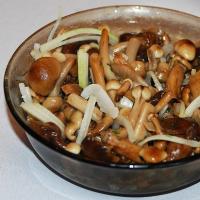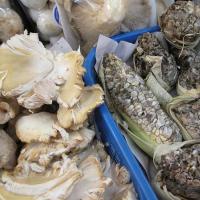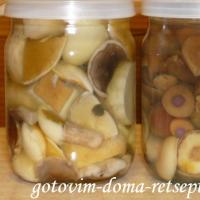Boletus mushrooms: description of species and cooking options
Boletus is famous not only for its pleasant taste, but also for its beneficial properties. Mushroom dishes are prepared simply, but they turn out incredibly tasty.
Boletus is famous not only for its pleasant taste, but also for its beneficial properties.
This is one of the most common and valuable mushrooms that can be found on the territory of Russia and the CIS countries. It belongs to the genus Lekcinum (another name is Obabok) of the Boletov family (famous representatives are boletus mushrooms), which include aspen mushrooms.
These are rather large mushrooms (up to 20 cm in diameter of the cap) with well-defined parts - the stem and the cap. The hat is round, prostrate or hemispherical, has no gloss, pleasant to the touch (velvet). Its color varies greatly: from light milky to dark brown, gray and even black. The older the boletus, the darker it is. The leg is straight, but slightly thickens near the mycelium. Contrasting scales are noticeable on it: white or black.
Grow fast enough(up to 3-4 cm per day), the most precocious by the 6th day reach their maximum length. After the pulp becomes more watery, mucus appears, which becomes an excellent bait for worms. After another 4-5 days, the fungus dies.
In the people, the mushroom is called boletus, birch, obabok or blackhead.
 Boletus is one of the most common and valuable mushrooms that can be found on the territory of Russia and the CIS countries.
Boletus is one of the most common and valuable mushrooms that can be found on the territory of Russia and the CIS countries. Where does the boletus grow
As you can see by the name, which the fungus received for good reason, it forms mycorrhiza with birches, therefore it is often found near them. Almost all species love bright places open to the sun. Appears in June after cherry blossoms, disappears in October or November.
Prefers forest-steppe zones, but feels good even in the tundra next to dwarf birches. Such individuals are jokingly called birch trees, because they are often much higher than these plants.
Boletus boletus are widespread on almost all continents: Eurasia and both Americas.
Where and how to collect boletus (video)
Edible types of boletus
All species of the genus Leccinum are edible, they differ slightly in their taste. They can be consumed raw, fried, dried, boiled or pickled, or frozen for the winter.
In total, there are about 40 species of boletus, but The following can be found throughout the country:
- Ordinary;
- pinking;
- marsh;
- multi-colored;
- black;
- harsh.
 Common boletus
Common boletus Common boletus
The most common type. It has a delicate and pleasant taste. You can distinguish it by a reddish hat with a brown tint. The gray leg is compacted, has a clear thickening at the bottom.
rosy boletus
Unlike its “brothers”, the cut of which darkens over time, this obabok acquires an unusual brick-pink hue. More common in swampy areas. You can recognize it by its characteristic low leg, which sharply bends to the side.
swamp boletus
Prefers moist soil and dark places. The color of the mushroom is light, the flesh is loose, it breaks well.
 Black boletus
Black boletus Birch multi-colored
Very beautiful representative, famous for its unique color. Hat of non-uniform color: dark base with white and beige stains, covered with yellow, orange, brick or grayish spots.
Black boletus
Rare mushroom. It is difficult to find it, it is a real success even for an experienced mushroom picker, because a dish made from them will be remembered even by those who do not like “forest bread”. The brown, bluish-black cap is noticeable from afar, the leg is almost completely covered with dark blotches.
Boletus harsh
The sweet and fragrant mushroom is quite tough, but after processing it becomes pleasant in texture. Thanks to the purplish-brown hat, obabok is difficult to confuse with other species. The thick stalk is smooth in old specimens, and strongly scaly in young ones.
 Boletus belongs to the second mushroom category
Boletus belongs to the second mushroom category Useful properties and taste of boletus
It is known that the mushroom was collected in the times of Ancient Rus', it was actively used for food and harvested for future use. But most often the blackhead was mixed with other mushrooms (porcini, mushrooms or russula), as it was believed that they did not have a pronounced taste. But today gourmets believe that this is one of the most valuable representatives of "forest bread", it just needs to be cooked correctly. But so far, the boletus belongs to the second mushroom category.
Its useful qualities are amazing:
- Fiber (of which a quarter consists of birch) helps to cleanse the body.
- Normalizes blood sugar levels, reduces glucose.
- Treats kidney disease.
- Calms the nervous system, helps to overcome insomnia.
- Suitable for cancer prevention.
- Useful for mucous membranes and maintaining good skin condition.
- Improves the functioning of the musculoskeletal system, joints and spine.
It is worth noting and low calorie "forest bread" and a high content of vitamins, micro and macro elements necessary for the normal functioning of the body. Therefore, boletus can be used by people who limit their diet, wanting to lose weight.
 Boletes are widespread on almost all continents.
Boletes are widespread on almost all continents. What does a false boletus look like
Mushroom picking is often referred to as silent hunting. And indeed, the mushroom picker is looking for his "prey", wanting to find the best. But dangers lie in wait for every hunt, and this process is no exception. It is important not to make a mistake and not confuse an edible mushroom with a poisonous one.
Bile (false) boletus practically does not differ from its tasty counterpart. He successfully imitates obabok, so often even experienced people make mistakes and bring the "liar" home. One small piece of gall can spoil the whole pan of other mushrooms, because heat treatment helps to fully reveal the unpleasant taste. False boletus is not poisonous, however, scientists believe that its pulp contains toxins that can worsen a person's well-being.
- "Imitator" is not eaten by insects, birds and animals, so it can be recognized by its untouched appearance.
- The wet surface of the caps quickly deforms when touched.
- There are no tubular veins at the bottom of the cap.
- The size of the gall fungus often exceeds the usual birch.
- There are no spots on the stem that a real blackhead has (resembling birch colors) and there are thin veins that look like blood vessels.
These signs will help to recognize the false boletus.
 Biliary (false) boletus practically does not differ from its tasty counterpart
Biliary (false) boletus practically does not differ from its tasty counterpart How to cook tasty mushroom boletus
Obabok often darkens during cooking, due to which its taste deteriorates a little, and its appearance becomes unpresentable. Therefore, it is desirable to soak it in a solution with citric acid. Don't keep the mushrooms in the water for more than 20 minutes or their texture will become too watery. After the birch trees, it is necessary to rinse and boil for 40-50 minutes, regularly removing the resulting foam.
Mushrooms in sour cream sauce
The first young mushrooms are especially tasty with tender rustic sour cream.
For the dish you will need:
- Mushrooms - 300-400 gr.;
- sour cream - 5 tbsp. l.;
- flour - 1 tsp;
- salt and spices - to taste.
Cooking steps:
- Cut the birch trees into small pieces.
- Fry them in a pre-heated pan. Wait until the moisture is completely gone. Add the onion to the dried mushrooms immediately.
- Salt the mixture and fry the vegetable until golden brown.
- At this time, dilute sour cream with spices (garlic, paprika, black pepper) and flour.
- Pour the mixture over the mushrooms and simmer for 20 minutes over low heat.
 False boletus is not poisonous
False boletus is not poisonous Omelette
An unusual breakfast diversifies the menu. You will need the following products:
- Boiled mushrooms - 150 gr.;
- eggs - 3 pcs.;
- milk - 2 tablespoons;
- hard cheese - 30-50 gr.
- salt, herbs - to taste.
Let's start cooking:
- Boletus fry for 5-10 minutes.
- Whisk eggs with milk.
- Pour the mixture into the skillet;
- After 3 minutes, cover with a lid and lower the heat.
- Wait until a crust forms on the base of the omelette and the top becomes fluffy.
- Sprinkle with herbs and grated cheese. The dish is especially tasty with croutons.
How to fry boletus (video)
Soup
Soup Ingredients:
- Mushrooms - 450-500 gr.;
- potatoes - 200 gr.;
- carrots - 50-70 gr.;
- onion - 2 small;
- tomato - optional;
- noodles or cereals - optional;
- greens - to taste.
Cooking process:
- Boil the mushrooms in brackish water.
- Add finely chopped vegetables (first potatoes, then tomatoes, followed by onions and carrots).
- Pour in cereal or noodles. The term depends on what exactly you have chosen, pasta can be filled up just before turning it off so that they do not boil soft.
- 10 minutes before stopping cooking, add herbs and spices.
What other mushrooms grow under a birch
Not only boletus grows near birches. This tree loves a lot of mushrooms:
- White;
- flywheel green;
- the breast is wet and aspen;
- Champignon;
- boletus;
- russula;
- raincoat.
It is worth spending a day picking a birch tree to enjoy its taste. But be careful not to pick up the gall fungus.
Let's talk secrets...
Have you ever experienced joint pain? And you know firsthand what it is:
- inability to move comfortably and easily;
- pain during or after exercise;
- discomfort when going up and down stairs;
- inflammation in the joints, swelling;
- unpleasant crunch, clicking not of their own free will;
- causeless and unbearable aching pain in the joints ...
Please answer the question: are you satisfied with this? Can such pain be endured? How much money have you already "leaked" for ineffective treatment? Time to end this! Do you agree? Today we are publishing an exclusive interview with Professor Dikul, in which the doctor revealed the secrets of getting rid of joint pain, treating arthritis and arthrosis.
Attention, only TODAY!



